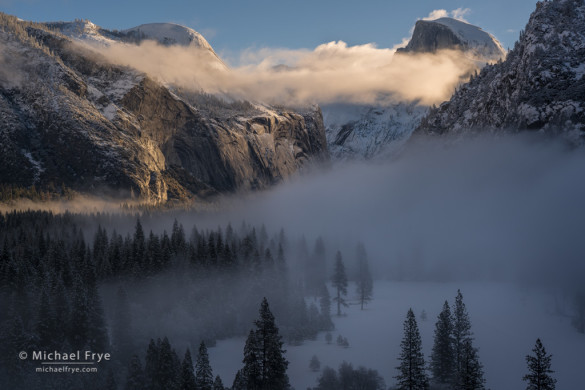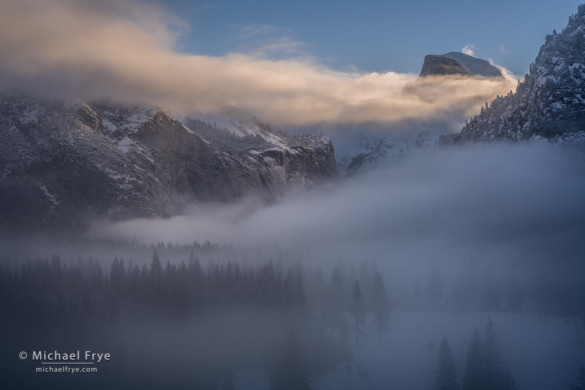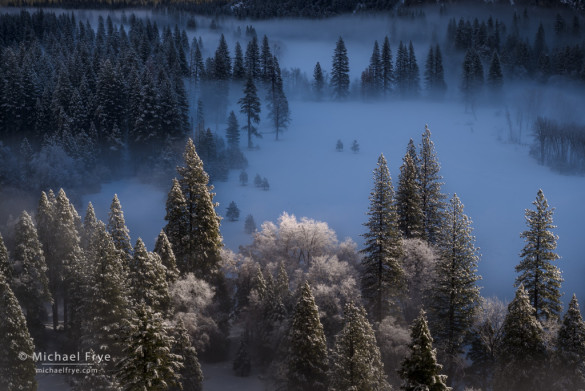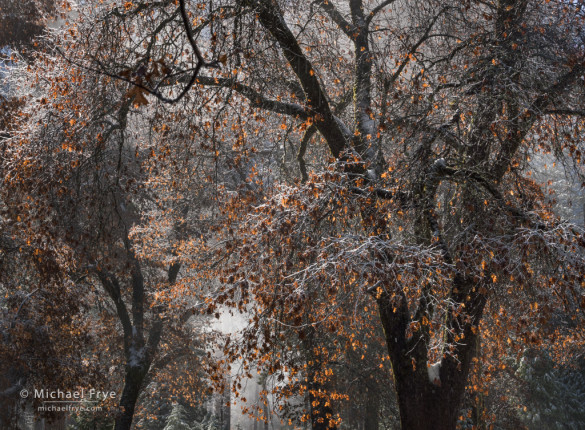I’m so grateful for all the rain and snow we’ve been getting. After four years of drought, it’s wonderful to have a normal, wet winter. We’ve had storm after storm, and although most of the recent ones have been small, they add up. Yosemite Valley has received 24.63 inches of rain since July 1st, which is well above average. Badger Pass, at 7,200 feet, has 60 inches of snow on the ground, and the deepening snowpack raises hopes of full waterfalls this spring.
All this weather has been great for photography. It seems like we’ve already had more snow and clearing storms this season than the last four winters combined.
The latest in the series of small storms came through on Thursday night. I didn’t pay much attention to it, because it was predicted to be a weak system, and a warm one. I happened to wake up at about 4:00 a.m. Friday morning, and checked the radar images on my phone. It was raining pretty hard at our house, but the radar showed that the precipitation might end soon, possibly right around sunrise.
That got my attention. Any clearing storm can be photogenic, but one that breaks up around sunrise or sunset has even more potential. I was suddenly wide awake.
The radar also showed snow, rather than rain, in Yosemite Valley. And the temperature in the valley was 32 degrees, which was cold enough for snow. But the park’s road and weather information line indicated that there was no chain control in the valley, and highways 120 and 41, both of which go all the way up to 6,000 feet in elevation (2,000 feet higher than the valley) were only R1 – chains or snow tires required.
Hmm… Yosemite Valley had received over three-quarters of an inch of precipitation at that point. That should translate to some four to six inches of snow at 6,000 feet – maybe more. Even a couple inches of new snow usually prompts the ultra-cautious park service to post R2 chain controls – chains for four-wheel-drive required. The R1 designation is used only when there’s a little slush on the road.
Something didn’t add up, but a clearing storm near sunrise was worth driving up there for, even if there was no new snow in the valley. Further checking of online satellite images confirmed that there was a good chance that the skies would clear soon, so I made some breakfast and got ready to go.
It was still raining hard when I left my house, but as I drove toward the park the rain stopped, and I saw stars several times through rifts in the clouds. Upon reaching Yosemite Valley I found lots of mist, with clear skies above, but no new snow, and my car’s outside thermometer read 35 degrees. Even at Tunnel View there was no snow in the trees – only some slush in the road.
Tunnel View looked like it would be socked in for awhile, so I decided to check the east end of the valley. If the online temperature gauge was right, it was colder there, so maybe there would be new snow. And sure enough, as I passed El Capitan I saw a slight coating of snow in the trees. As I drove further east the snow increased, with about two or three inches of new snow near Yosemite Village.
This wasn’t the first time I’d seen snow at the east end of the valley, but not at the west end. The distance is only five miles, and the elevation difference less than 100 feet, but sometimes that’s enough to create a slight dusting of snow in the east end when there’s nothing at the west end. But I’d never seen this big a difference, with two or three inches of snow at the east end, and nothing at the west end. No snow at Tunnel View even, which is 500 feet above the valley floor.
In any case, it seemed like a good day to be in the east end of the valley. I climbed up a rough, boulder-strewn talus slope to a familiar spot with a slightly elevated view over the east end of the valley. The footing on those loose rocks is difficult even when they’re dry, but even more treacherous covered with six to eight inches of old and new snow. I took my time and made it up safely.
Half Dome stayed hidden in the mist for awhile. I saw a few tantalizing glimpses, but each time the fog would close in again. Finally, at about eight o’clock, Half Dome came out for good. Waves of fog rolled over the valley floor below, alternately hiding and revealing trees and meadows, and adding a beautiful misty mood to the scene.
Eventually the mist near Half Dome dissipated, but there was still fog swirling over the valley floor. I concentrated on photographing more intimate scenes of misty trees, and hung around long enough for the sun to climb up over the south rim of the valley and light the trees below.
Fog, mist, fresh snow, and a storm clearing just after sunrise – what more could you ask for? I’m glad I woke up and checked the weather!
— Michael Frye
Related Posts: A Snowy Day; A Snowy Morning
Did you like this article? Click here to subscribe to this blog and get every new post delivered right to your inbox!
Michael Frye is a professional photographer specializing in landscapes and nature. He is the author or principal photographer of The Photographer’s Guide to Yosemite, Yosemite Meditations, Yosemite Meditations for Women, Yosemite Meditations for Adventurers, and Digital Landscape Photography: In the Footsteps of Ansel Adams and the Great Masters. He has also written three eBooks: Light & Land: Landscapes in the Digital Darkroom, Exposure for Outdoor Photography, and Landscapes in Lightroom: The Essential Step-by-Step Guide. Michael has written numerous magazine articles on the art and technique of photography, and his images have been published in over thirty countries around the world. Michael has lived either in or near Yosemite National Park since 1983, currently residing just outside the park in Mariposa, California.













Hello, Michael. Thank you for sharing your art. I enjoy your work tremendously. Do you have an arrangement for selling canvas prints? I am interested in pricing for “Misty Morning”; size would depend on cost. Kind regards, Bonnie.
Thanks Bonnie, and I’m glad you like the photograph. I don’t sell canvas prints, but if you might be interested in a more traditional print let me know.
Hi Michael,
Great photos! Wish I was there!
Cheers,
Alyn Brereton
Thank you Alyn!
The last photo: best of the bunch. Wonderful depth.
Thanks Marshall!
Michael,
I’m curious. Were your overlook photos taken from Columbia Rock or elsewhere?
Thanks!
Cheers,
Alyn Brereton
Alyn, I was not at Columbia Rock, but I’d prefer not to share the exact location for a number of reasons, not least of which is that getting there involves traversing rough terrain that is likely to break somebody’s ankle, and I don’t want to be responsible for that.
Wow, Michael, great images! Plus, it is wonderful to hear that the snow and rain totals are looking good this winter.
Thanks Robin, and all the snow and rain is indeed wonderful news.
Amen to your decision. Thankfull you woke when you did.
Thanks – I’ll second that. 🙂
I really enjoyed this post. The decision process of why you chose to go and what sites to consider when things are in a constant progression of change was, for me, just as or more important than the equipment and settings used to convey what you saw once you got there. With your depth of local knowledge, though, you can interpret the data more than a visitor could. Thanks for sharing how you evaluate the potential. And great photos too.
Thanks Craig, I’m glad you enjoyed it. Local knowledge is always a big advantage, which is a good reason to get to know places in your area.
As much as I love the snow and fog around Half Dome, the black oaks with snow and mist is really stunning. I like the way the snow outlines the shape of the trees and how the leaves add just a little subtle punch of color.
So happy to hear about all the precipitation out your way!
Thanks very much Vivienne – I’m glad you like that photo. It was a beautiful morning in many ways.
Michael,
Your unwillingness to reveal the exact location of your overlook shots is perfectly understandable. I was quite certain that Columbia Rock wasn’t the spot because of the angle of the photos taken. Getting to the Rock would also have involved a one-mile trek along a snow-bound trail with an elevation gain of 1,000 feet. That would entail a bit of effort and risk in itself.
I wish I was a bit closer to the Valley in order to take advantage of this winter’s constantly changing weather conditions. Mariposa is a great home base for springing into action when the time is right. I’m envious.
I wish you safe travels!
Cheers,
Alyn Brereton
>Getting to the Rock would also have involved a one-mile trek along a snow-bound trail with an elevation gain of 1,000 feet. That would entail a bit of effort and risk in itself.
Effort for sure, not only because of the elevation gain, but plowing through snow along the way. I don’t think that it would be that risky though.
Hi Michael:- Yet again some fantastic images.
These are so beautiful, as with all of your work.
I always look forward to your posts.
“Beautiful”
John Robert McNally
UK
Thanks so much John!
Michael-
Awesome images, especially of the Valley. Don’t blame you for not disclosing the location. Its like someone asking me where my favorite “honey hole” is for trout. Glad that things worked out for you on the images. Love checking my e-mail in the mornings to see what new gems you have posted.
Thanks for posting.
Bill
Thanks Bill!
Michael,
Just when I think I have seen your best work you post something even better! I “practiced” medicine for many decades and the word “practice” is appropriate because it implies we all can improve. You continue to set a pretty high bar for those of us who practice photography!
Jim
Thank you for sharing your experience and process – it was a photographer’s adventure story! And I appreciated learning more about the Valley and what it does sometimes. The images are magical.
Thank you so much Joolz!
Michael, those are all quite beautiful. I do especially like the first one though. Thank you for sharing and please do be careful out there. No photo is worth serious injury. We want you around for a long time to come.
Thanks John, and don’t worry, I’m always careful, and very experienced negotiating mountainous terrain.
Hi Michael,
Beautiful pictures, as always!
I arrived at the valley around 5:00 am on the same day from Bay Area and totally agreed with your observation. Very interesting to see snow on the east side but rain on the west. However, I decided to stay at the tunnel view. The clearing happened around 7:50 and was also magnificent. Thanks for sharing your story and pictures on the east side. I feel like being at both places at the same time.
Look forward to more of your stories and see you on the trail.
Best,
George
Glad you got to be there George. I was wondering what it was like from Tunnel View Friday morning, so I’d love to see one of your images, if you are able to post a link to one.
Dear Michael,
I just sent you one image of Friday morning tunnel view via email. Hope you like it.
Best,
George
Very nice image George, thanks! I suspected it was a nice morning at Tunnel View, and your photo confirms that.
Michael,
Sublime as always! I’m glad to see this discussion about the fickle weather/road conditions, because I’ve been trying to plan a couple-day visit to Yosemite, but am 4+ hours away, and it’s a giant guessing game!
Care to elaborate on vehicle choices? I have 2 FWD sedans, one with snow tires in the winter. Is AWD a real bonus in your opinion? What do you use/recommend?
Thanks for the info AND the inspiration!
Ron